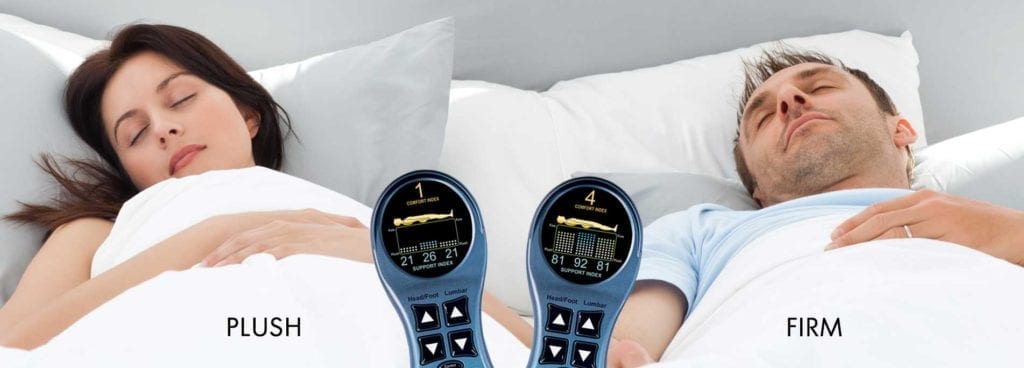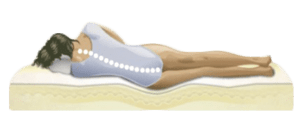
Adjustable Airbeds for Bedrooms
In 1981, Comfortaire introduced the first adjustable airbed designed for use in home bedrooms. The founder of Comfortaire left the company to found Select Comfort, which introduced the Sleep Number beds, with numbered settings and dual control (separate settings for two sleepers). This company became well-known with the trademarked question, “What is your Sleep Number?” Just as Tempur-Pedic became the brand representing memory foam mattresses, Sleep Number became the brand most identified with adjustable airbeds (Select Comfort now owns Comfortaire, putting these two brands under one umbrella).
Airbeds and Waterbeds
At the time the Comfortaire airbed came on the market, waterbeds were gaining in popularity because of their evenly-distributed support bringing pressure relief. Airbeds offered the same appeal, a feature known from recreational air mattresses. Three of the advantages adjustable airbeds have over waterbeds are:
Adjustability: The pressure of a waterbed cannot be adjusted while in use, but the pressure in an airbed can be adjusted by the persons lying on it. The air is pumped into the airbed from the room air, and it let out into the room. Adjusting the level of a waterbed is rather inconvenient, since water has to come through a hose attached to a faucet, and water let out has to be drained into a container or a drain.
Weight: Waterbeds are the heaviest beds on the market – heavier than any foam or innerspring mattress. The only thing close would be a thick layer of solid gel. An airbed on a bed frame with casters can be easily moved, something not done with a waterbed. Another consideration related to weight is the structural stress this can put on the floor.
No Leak Damage: A leak in a waterbed can lead to damage of the floor and anything sitting on the floor, which is why most waterbeds have waterproof liners in the frames.
Airbed Brands
There are several brands of adjustable airbeds. Most waterbed manufacturers also make airbeds. Some of these no longer make waterbeds, but still have airbeds.
Five of these airbed brands are compared by Sleep Like the Dead: Air-Pedic by Selectabed, Night Air Bed by Boyd Specialty Sleep, Habitat Furnishings, Innomax, Personal Comfort by American National Manufacturing (also a waterbed maker), and Sleep Number by Select Comfort. Of these, Air-Pedic has the highest customer satisfaction rate (83%), followed by Habitat Furnishings (82%), Boyd (81%), Innomax (78%), Personal Comfort (78%), and Sleep Number (77%).
Among other manufacturers and brands of bedroom airbeds are Strobel Technologies, United States Watermattress, Vinyl Products Manufacturing (Feather Edge), Comfort Craft, Euro AirBeds. The airbeds sold on Amazon and Walmart are inflatable mattresses intended for temporary use, not as replacements for innerspring or foam mattresses on regular beds.
Mid-2017, Select Comfort began to end third-party sales of Comfortaire mattresses. Unless they begin to sell them directly, this will be the end of the older brand.
Adjustable Airbed Construction
Adjustable airbeds share the same basic construction, though details differ by brand and model.
Air Chambers
Common to all airbeds are air chambers. An air chamber is a bladder made of a tough yet stretchable material. The most common bladder materials are natural or synthetic vulcanized rubber, medical grade urethane (similar to synthetic rubber), vinyl, and nylon. Some manufacturers reinforce this with fibers, such as cotton, rayon, or nylon. For example, Sleep Number uses rubber, Air-Pedic uses urethane, and Vinyl Products Manufacturing uses vinyl.
It has a port to which a hose (air line) is connected. The other end of the air line goes to an air pump. This is controlled by a hand-held remote control, which may be wired or wireless. This pump inflates the bladder to a set pressure, then maintains that pressure.
The air chamber is in a fabric sock (or cover) and rests on a pad, The top will have some kind of padding, ranging from a few layers of cloth to fiber padding to one or more layers of foam. The foam may be polyurethane foam, memory foam, or latex.
A single comfort air bed has only one air chamber. Dual comfort airbeds have separate chambers for two sleepers.
One or Three
Airbeds can have one or three chambers per side: 3 for single comfort, 6 for dual comfort. A 3 or 6 chamber bed has chambers for the head/shoulders, mid-section, and feet/knees. The concept is that the center chamber can be firmer for the heaviest part of the body. The concern is hammocking, which is the heavy hip area pushing down in the middle, pushing the ends higher, putting strain on the spine.


Above the Air
In an airbed the air chambers are the support core (also called the “lower box”). In most airbeds, a significant portion of the mattress height is taken by comfort layers (in the “upper box”), intended as padding. These are usually layers of foam, which may be polyurethane foam, memory foam, or latex. Other fillings may include polyester fiber. This raises the mattress from a 6” or 8” height to 10” to 15” or more.
Most bedroom airbeds come in standard sizes and use sheets made for regular mattresses.
Advanced Features
The single advanced feature which made airbeds popular are numbered settings on remote controls. This concept was publicized through ads by Select Comfort for their Sleep Number beds. However, American National (the maker of Personal Comfort airbeds) was using number settings before Select Comfort.
Other advance features now include smart bed technology. Sensors detect sleeper movements, etc. and control unit microchips interpret these to adjust the airbed for better sleep. This means air pressure, but can also conceivably include air temperature. If applied to a 6-chamber airbed, this would include the differential of the middle chamber to the end chambers. For an airbed on an adjustable base, the position of the base is also automatically controlled.
Prospects
The end of waterbeds was predicted with the rise of adjustable home airbeds and memory foam mattresses, but waterbeds are still here – they may not have their previous popularity, but they have not gone away. Likewise, airbeds are here to stay for the foreseeable future. With the application of smart bed technology and the use of foam comfort layers, they will hold their own.

